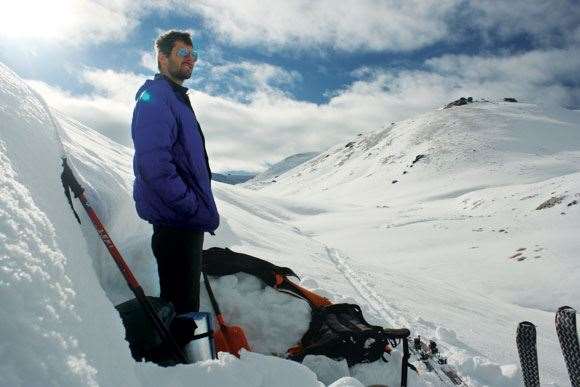New Zealand’s South Island has more snow than it knows what to do with ... so get over there and play in it.
New Zealand’s South Island has more snow than it knows what to do with ... so get over there and play in it.
Im sitting shotgun as our ride cuts between the highest peaks in New Zealand. The plane is one of those slender jobs with massive windows that do wonders for viewing but little for fuselage strength. The mountains, meanwhile, are great black blades of granite rising at impossible angles out of valleys pillowed with snow and rumpled with glaciers. Beside me sits the pilot, Ivan, wearing the requisite pair of reflective aviators. To our left is Mt Cook, Aoraki, “The Cloud Piercer” ‒ the highest peak in New Zealand, with its three pinnacles punctuating a two kilometre-long knife ridge. Straight ahead is Mt Tasman, Horo-Koau ‒ a steeper, triangulated wedge of rock bulging with deadly seracs and ice cliffs. The sun’s out and the sky’s blue and the snow’s corruscating. It’s astonishingly beautiful.
Ivan’s voice crackles over my headphones: “See that valley to your right?” I peer out the window. There’s no valley, just a blinding field of snow. “Ah, no.” Ivan laughs. “Well, you wouldn’t, ‘cause it’s full of snow. But there’s a valley there – 800m deep – and it’s filled to the brim with snow.” I look out the window again. The sweep of snow looks fat and soft, a huge meringue gleaming in the midday sun. I try to picture that meringue going down and down and down, for 800m. But I can’t. Coming as I do from a hot, flat land, imagining that much snow is a bit of a stretch.
The point of this little story is that there’s a lot of snow in New Zealand. Masses and masses of the stuff. There’s reams of light fluffy powder and there’s packs of prehistoric ice. With its Tolkienian mountains and its oceanic breezes and its southerly disposition, the place is positively sagging under the weight of its snow. All of which can make for plenty of fun when the days shorten and the nights grow cold – especially if you’re from a land that is, as mentioned, hot and flat and typically built for surfside action rather than mountain-top skylarking.
The snow, of course, is so ubiquitous that it shows its face everywhere. I drive out of Christchurch airport, spin around a couple of roundabouts and – bang – there are the Alps filling the horizon, clean and white and wonderfully geometrical. My mouth falls open and I damn-near swerve into an oncoming semi stacked with ranks of ruminative sheep. They look thoroughly bored by their surroundings ... Stupid, spoilt sheep. I nose onto the main highway and head south, the Alps on my right. The road curls up as the mountains move closer. I find myself staring out the side window. More than once a fretful horn blast sends me back into my own lane. Hereabouts, signs dot the road instructing drivers to slow down, but really they’d be better served instructing you to keep your eyes off the scenery. It’s impossible not to stare. But I can only look for so long. By the time I hit Johnson’s Pass, where slivers of ice show on the side of the road and Lake Tekapo stretches before me, I turn my thoughts to skiing.
The options, of course, are myriad. If you need to rediscover your snow feet after a long summer, head to Roundhill, an aptly named knob of granite that rises above the eastern shore of Lake Tekapo. It’s a friendly little patch of snow with gentle runs that allow me to get away with some outrageously bad skiing. But any number of gammy-footed stacks are well worth the view from the top of the hill, which looks straight across the lake, coloured like Charlize Theron’s eyes, and onto the ragged peak of Mt Cook, a soft orange beneath the afternoon sun. Once more, my mouth drops open. A steering wheel beneath my hands right now would be a truly dangerous thing. Instead, I have a pair of skis on my feet that simply won’t do what I’m asking of them. No matter. Even buried on the hillside, my skis tangled, my jacket stuffed with snow, the view’s still wondrous.
 bottom photo by Gary Lisbon. top photos courtesy Matt Cleary.
bottom photo by Gary Lisbon. top photos courtesy Matt Cleary.If Roundhill sounds a touch tepid, then keep going south until you hit Cardrona, half an hour past the pubs and cafes of Wanaka. The runs here are steeper and more nuanced, but so wide I feel like I have the place to myself and my lissome Japanese instructor, Naoko, who gently implores me to get my weight over my knees. No such luck. I lean backwards, take a wrong turn, and find myself on a black-diamond moguls run. As I scrape spadefuls of snow from my jacket, Naoko kindly suggests we do the skyline run, a gentle path that cuts along the ridgeline of the mountain. “It’s very beautiful,” she says nervously. And she’s right – to the south lies Lake Wakatipu, fringed by the Remarkables and the tiny grey splash of Queenstown. To the north lies Lake Wanaka, shadowed by the peak of Mt Aspiring. And everything in between is a shimmering of white mountains.
From Cardrona, I head south again until I hit Coronet Peak, a bare 20 minutes outside Queenstown. This is a mountain from Peter Jackson’s central casting. The vertical drop from peak to base measures precisely 462m, and most of that comes at a precipitous gradient, with supposedly harmless blue runs disappearing beneath my skis at a gut-loosening pitch. But rest assured, the landing is soft. With a chiselled 1649m peak, an annual snowfall of two metres, and runs banked by exactly 141 snowmaking guns, this mountain has more powder than it knows what to do with. I totter and tumble with the best of them, before retiring to the smoking pubs of Queenstown to see what Messrs Speight’s and Monteith’s have to offer. Plenty, I discover.
It would, of course, be remiss to talk of the slopes without mentioning where a pair of bone-sore legs can find a warm bed. Again, the options are numerous. After a fuzzy, homey atmosphere? Then head to the Te Wanaka Lodge. Even by the genial standards of New Zealand’s deep south, owners Wayne and Mandy could talk the ear off a cud-chewing sheep. Which is fine by me, particularly after the Wallabies upset the All Blacks on the Saturday evening I’m in residence. The next morning Wayne rumples his brow, mutters something about being a Warriors fan anyway, and retreats to his back office.
Conversely, if down pillows and starched linen sheets are more to your liking, then head to The Dairy. The silver-tray afternoon teas are a glorious miasma of butter and sugar and strong black coffee. It should be noted that both establishments do an open-air hot tub that bubbles late into the night, and an honesty bar stocked with the finest Otago pinot noirs. I combine the two. Believe me, it works.
But after a while there’re only so many groomed runs I can mangle, so many bottles of pinot I can chug, so many steaming hot tubs I can muddy. Even though it looks like the slenderest sliver on a map, the south island is a surprisingly large rumple of land. There are mountains beyond count, valleys beyond number, empty spots beyond imagining. It’s all well and good to glance at them from the top of a run or the seat of a plane, but something compels me to take a closer look. So I knock on the door of Wanaka’s Aspiring Guides and ask them to give me a taste of this island’s rugged backcountry.
My guide, Pete, looks like a mountain climbing cliche. He projects an unflappable gaze best deployed on avalanche-prone slopes or crevasse-riddled glaciers. It’s the sort of gaze that could make a grizzly bear about-face. I tell Pete I’ve had a few days sampling the good things in life. Now I’d like a challenge. Live rough for a night. See the wilds up close ... He suggests we think about the trip in terms of scenarios. We could pretend we’ve gone out for a day of ski-touring, got lost, and had to survive the night in a snow cave. “Of course,” he says, “if we follow this scenario, it means no sleeping bags, no mats, no stove, bare rations.” I ask him how we’d spend the night. He winces: “Well, we’d probably sit on our packs in the snow cave and spend the night back-to-back ... ”I suggest a marginally less severe scenario. Pete looks disappointed. Eventually we compromise on a plotline where we’ve gone out for an overnight ski trek, but got lost and missed our hut. We’ll still spend the night in a snow cave, but we’ll have sleeping bags, a stove, plenty of grub ... and maybe a dash of red wine.
The next morning we head off into the Pisa Range, our packs laden with rations to satisfy an army, and a two-litre flask of shiraz. The scenario seems to have softened somewhat. Still, the weather forecast is predicting a front bringing half a foot of snow and gale-force gusts of wind. I reason that if we are to spend the night buried in the icy side of some nameless mountain, battered by wind while the door of our cave fills with snow, then it’s probably best to do it a little tipsy.
Touring skis are, in fact, a remarkably efficient way of moving through snow-covered wilderness. We glide along, tracking a frozen stream, wending our way along the floor of a valley into the depths of the Pisas. As the afternoon wiles away, Pete explains the basics of frozen backcountry survival. Lesson number one: moisture is your enemy. Rain, sweat, melted snow – all can be deadly. A wet body is a cold body, and if you’re wet when night closes in, you’re in a world of strife. For this reason, we move beneath the sweat zone, ambling along at a gentlemanly pace, coasting on the downhills. This wisdom, however, doesn’t seem to apply to digging a snow cave. I hack away at the designated snow floe like a madman, rolling in the snow, pressed tight in the tunnel of ice, sweat pouring off me. It takes a solid two hours of toil before we’re done. My shoulders are burning. I’m drenched through. And then the unthinkable happens.The flask of shiraz falls from my pack, skids down the hillside, breaks the snow cap, and disappears into the stream we’ve been tracking. Pete fixes his mountaineer’s gaze on the hole in the snow. There’s the slightest tremble in his jaw: “Tell me that didn’t just happen.” We spend the next half hour scouting the stream, poking our ski poles through the snow, peering desperately into the shadows. But it’s no use – the flask’s gone. Pete raises his gaze to the western horizon. Already the predicted front’s massing in a dark, bruised mess. We retire to our lodging. In the afternoon sun it had looked cosy. Now, in the evening gloom, with the wind picking up, spindrift falling, it reveals itself as no more than a dripping tunnel of ice.
But, as seems to be the way of things in this snow-covered land, the cave is actually surprisingly comfortable. Not quite as comfortable as The Dairy’s down pillows or Te Wanaka Lodge’s hot tub, but it’s warm and dry. I scarcely hear the wind, and Pete does magical things with a gas stove and a packet of couscous. Sated and leg-sore, I sleep the sleep of the woodsman. And when I wake it’s to a sun-bathed valley, covered in fresh snow, the powder scarified by the night’s winds, the stream tinkling softly, the fresh tracks of hares lining the slopes, all viewed through a doorway of ice I fashioned myself. I tell you, long after I’ve forgotten the ridgeline of Aoraki, long after I’ve forgotten the name of my favourite Otago pinot, long after I’ve forgotten the feeling of the Coronet Peak slopes dropping beneath my skis, I’ll remember that view. Luxury’s all well and good, but there’s something deeply satisfying and wonderfully exotic about carving your quarters out of a snowdrift. Get there soon and you may just find yourself a gratis flask of shiraz ...
 bottom photo by Gary Lisbon. top photos courtesy Matt Cleary.
bottom photo by Gary Lisbon. top photos courtesy Matt Cleary.‒ Aaron Scot
Related Articles

Course Review: Cape Kidnappers

Aussie Green maintains lead in Champions Tour major













